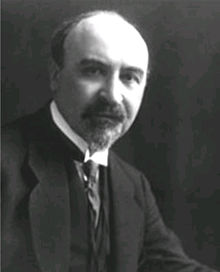Leo Hendrik Baekeland
Leo Hendrik Baekeland (born November 14, 1863 in Ghent , † February 23, 1944 in Beacon , New York ) was a Belgian - American chemist and inventor. Baekeland developed the first mass-produced plastic Bakelite between 1905 and 1907 .
Life
The son of the shoemaker Charles Baekeland developed interests in science and economics at an early age. As a young student at an evening school, he received awards in chemistry , physics and economics. A scholarship enabled him to study chemistry at Ghent University from 1880 . In 1884 he did his doctorate at the age of barely 20. In addition to teaching at a secondary school, he worked from 1888 as an associate professor of chemistry at the University of Ghent. In 1889 he married Celine Swarts, the daughter of his former professor of chemistry, Theodore Swarts .
During a study trip in 1889, he decided to stay in the USA . From 1893 he ran a manufacturing company - the Nepera Chemical Company (Nepera Park, NY). He sold the rights to a photo paper he had developed (Velox) (a type of paper for quickly developing photos in artificial light) in 1899 for one million dollars to the Eastman Kodak company . This money enabled him to continue his studies in his own private laboratory. After investigating electrochemical processes, from 1905 he turned to the condensation reaction of phenol and formaldehyde, known since 1872 ( Adolf von Baeyer ) . A self-developed autoclave (Bakelizer), which can be optionally heated and cooled, enabled him to control the temperature of the chemical reaction under excess pressure. In numerous experiments he determined the factors influencing the course of the reaction. He was supported by his assistant Nathaniel Thurlow (1873-1948).
In 1909 he received the important heat-pressure patent. In the following years there were patent disputes that he was able to win. At the end of 1910 he and his opponents founded the General Bakelite Company, which was taken over by Union Carbide in 1939 .
In Germany, the Rütgerswerke acquired a license and began manufacturing Bakelite in 1909. To this end, Baekeland founded the Bakelite Gesellschaft mbH in Erkner near Berlin on May 25, 1910 together with the Rütgerswerke founded by the entrepreneur Julius Rütgers . The plant was nationalized in 1948 as VEB Plasta Erkner .
In the years after 1910, Baekeland held numerous honorary positions in addition to his work as President of the Bakelite Corporation.
He received numerous awards for his services: in 1910 he received the William H. Nichols Medal of the American Chemical Society , in 1913 the Willard Gibbs Medal of the American Chemical Society and in 1940 the Franklin Medal of the Franklin Institute . In 1935 Baekeland was elected to the American Philosophical Society and in 1936 to the National Academy of Sciences . In the same year he became an Honorary Fellow of the Royal Society of Edinburgh . He is on the "List of the 20 greatest thinkers and scientists of the 20th century" published by the American Time Magazine on March 29, 1999.
Baekeland is buried in Sleepy Hollow Cemetery .
In his honor, which is Leo Baekeland Award of the ACS named.
Works
- Velox, a photo paper that can be exposed to an artificial light source.
- Use of a heatable and coolable pressure vessel.
- Explanation of the condensation processes that lead to the formation of phenolic resins . Together with H. Lebach, introduction of the terms novolak for resin under acidic condensation conditions and excess formaldehyde, as well as resol (Bakelite A) for resins under alkaline reaction conditions and excess phenol. Furthermore Resitol (Bakelite B) for the hardenable molding compound made of Resole, and Resit (Bakelite C) for the hardened resin.
literature
- Charles F. Kettering : Leo Hendrik Baekeland, 1863–1944 . Ed .: National Academy of Sciences (= Biographical Memoirs . Volume 24 ). Washington, DC 1946, p. 281-302 (English).
Web links
- German Plastic Museum: Leo Hendrik Baekeland
Individual evidence
- ↑ Life data, publications and academic family tree of Leo Henricus Arthur Baekeland at academictree.org, accessed on January 6, 2018.
- ↑ TIME Magazine .
- ^ Silvia Glaser: Bakelite . In: Historical plastics in the Germanic National Museum . Verlag des Germanisches Nationalmuseums, Nuremberg 2008, ISBN 978-3-936688-37-5 , p. 14
- ^ Company history ( Memento from April 4, 2004 in the Internet Archive ) on the former homepage of Bakelite AG.
- ↑ newyorkacs.org: Nichols Medalists , accessed on July 29, 2014.
- ↑ shaper RSE Fellows 1783-2002. Royal Society of Edinburgh, accessed October 7, 2019 .
| personal data | |
|---|---|
| SURNAME | Baekeland, Leo Hendrik |
| BRIEF DESCRIPTION | Belgian-American chemist, inventor of Bakelite |
| DATE OF BIRTH | November 14, 1863 |
| PLACE OF BIRTH | Ghent |
| DATE OF DEATH | February 23, 1944 |
| Place of death | Beacon |
